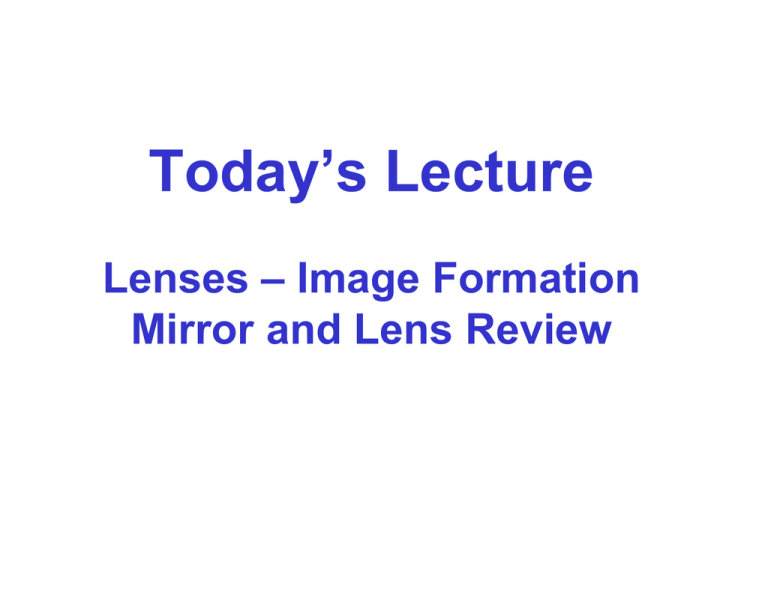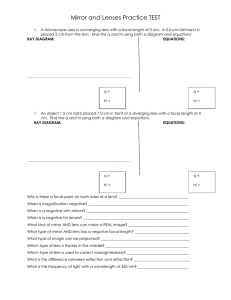Today’s Lecture Lenses – Image Formation Mirror and Lens Review
advertisement

Today’s Lecture Lenses – Image Formation Mirror and Lens Review Thin Lenses A thin lens consists of a piece of glass or plastic, ground so that each of its two refracting surfaces is a segment of either a sphere or a plane (a sphere of infinite radius) … A lens is thin when the radii of curvature are much bigger than its thickness. Lenses have two major applications: light collection and imaging Diverging lenses are Converging lenses are thickest at the edges and thickest in the middle and have negative focal lengths have positive focal lengths Converging Lens and its Focal Length, f Light collection: The parallel rays pass through the lens and converge at the focal point. The parallel rays can come from the left or right of the lens. A thin lens has two focal points equidistance from the lens, corresponding to parallel rays from the left and from the right. A thin lens is one in which the distance between the surface of the lens and the center of the lens is negligible compared to f. Converging Lens and its Focal Length, f The parallel rays diverge after passing through the diverging lens. The focal point is the point where the rays appear to have originated. Imaging f l Three principal rays emanating from every point of the object: 1. A ray parallel to the axis of the lens on the front side passes through the focal point on the back side. 2. A ray that passes through the center of the lens and does not get refracted. 3. A ray that passes through the focal point on the front side emerges parallel to the axis of the lens on the back side. Ray Diagram for Converging Lens l f If the object is further away from the lens than the front focal point, l > f , => the image is real, inverted, and located behind the lens. If the object is located at more than 2f, l > 22f, => the image is reduced. If the object is located at f < l < 2f, the image is magnified. WHY? What is different between a concave mirror and a converging lens? Ray Diagram for Converging Lens f l If the object is closer to the lens than the front focal point, l < f, => the image is virtual, upright, magnified, and in front of the lens The image can only be viewed from behind the lens! Since the image is larger than the object, this is configuration for a magnifying glass! Ray Diagram for Diverging Lens. The situation is pretty much the same no matter where the object is located. l f The image is virtual, and can only be seen through the lens. The image is upright and is always reduced in size compared with the object. Note the analogy with convex mirrors! Lens Magnification l The two shaded triangles, blue and gold, are right-angled and similar. Therefore, for the lens magnification, M, we have: In an exact analogy with mirrors, the “−” sign is taken to signify the fact that the image is inverted. l’ Lens Equation l l’ Consider the similar right triangles defined by the angle θ. From the magnification we know that –h’/h = l’/l. Since these triangles are similar: The “Lens equation” is the exact form as the mirror equation. l and l’ are both considered positive for the case shown. Whereas l’ is positive in the mirror equation when the image is in front of the mirror. http://www.mtholyoke.edu/~mpeterso/classes/phys301/geomopti/lenses.html Summary for Converging Lens Image real, inverted, reduced (magnified for l < 22f ). This can be seen via: Virtual, upright, magnified Lens Magnification – Diverging lens ℓf f ℓ and M ℓ−f f−ℓ ′ f 0, ℓ − anything, ℓ ′ 0 and |ℓ ′ | ℓ; M −ℓ ′ /ℓ, M 1 Virtual, upright, reduced To Summarize for both types of lenses: What happens to the image if we put in an aperture? If we remove the lens? Top and bottom of image are less bright. Top half of image is less bright Who has seen the lens?! I O I O Who has seen the lens?! O I O I Lens aberrations, spherical: Ideally, the surface of a lens should be parabolic… Those are very difficult to make, though! Spherical shape is rather close to a parabola for paraxial rays, which are close to the axis of the lens. The rays, which come at greater angles (further away from the axis) converge in a different, closer point. The image of the point O gets blurry… Lens Aberrations, Chromatic Regular glass materials are dispersive: indices of refraction are different for different colors. Rays of different colors are refracted through different angles and converge in different points – the image gets blurry! Remedies – try to use a single color illumination or a composite lens compensating for the dispersion. High end microscope objective collect light from wide angles and compensate for all possible aberrations… Imagine a camera with a single lens with a focal distance f = 35mm. By how much and in what direction should the lens be moved to move its focus from an object, which is far-far away to an object at a distance of 1.5m? Far-far away means l = ∞, and l’= f = 35mm. New distance l = 1.5m; l’= ? A movie projector. Where is the film with respect to the focal point? Image Formation with a Lens – Fine Print You have a magnifying lens has a focal length of 30cm. How far from the page should you hold the lens in order to see the print enlarged 3x? First note that the image is on the same side of the lens as the object, the page! This means that the image distance is negative. Hence: From the lens equation: This result means that the lens is 20cm above the page and the image is 40cm below the page, and the image is upright. The diameter of an eyeball is about 22mm in diameter. It focuses light emanating from different objects onto the retina to produce sharp images. Most of the focusing job is done by the cornea, which acts as a fixed lens with a focal distance of 22mm. The lens is only doing some fine tuning to move the focusing from objects which are far-far away to objects which are close. A healthy human eye can clearly see (focus) objects at distances from infinity to about 25cm. How is that achieved? By changing the focal distance of the lens! We always have l’≈ 22mm. Far-far away means l = ∞, and f = l’ ≈ 22mm. An object at l = 25cm means The adaptive lens driven by the eye muscles changes the focal distance of the eye by “only” 9%. But this is quite a lot!.. Myopic (shortsighted) eye – the lens is always “too strong”, that is too much converging and if the object is far away it creates its image in front of the retina. So, the light pattern on the retina becomes blurry, out of focus. The eye can be helped by a negative, diverging lens, which creates virtual images of far away objects closer to the eye. Rephrasing it: the diverging lens + the “too much” converging lens in the eye make a composite lens of the right converging power. The power of the corrective lens is P=1/flens (diopters, m-1) Hyperopic (farsighted eye) – the lens is sometimes not quite strong enough. If an object is close it focuses behind the retina. So, the light pattern on the retina becomes blurry, out of focus. The eye can be helped by a positive, converging lens, which creates magnified virtual images of close objects further away from the eye. Rephrasing it: the additional converging lens + the “not strong enough” converging lens in the eye make a composite lens of the right converging power. Optics in Review Electromagnetic waves (light) all propagate in vacuum at c=3x108 m/sec In a transparent medium with refractive index n, the speed is v=c/n. The frequency of the wave remains constant, hence λ=nλn. With an angle of incidence between two different transparent mediums, θ1, Snell’s Law Mirror’s and Lenses What is the difference between the lens and mirror equations? Meter Stick If you look into the corner of the cube at 45o (as shown) what mark on the meter stick do you see if (a) The tank is empty? (b) The tank is half full? (c) The tank is full? 40cm doh! Critical Angle When light is propagating in glass with n=1.52, what is the critical angle when the glass is immersed in (a) water (n=1.33)? (b) Benzene (n=1.50)? (c) diiodomethane (n=1.738)? Displaced Laser Beam l Find the displacement of a laser beam that is approaching a 5cm thick layer of ice with an angle of incidence of θ1 = 30o when ice has an index of refraction of n=1.3. Defining the diagonal through the slab as l we find: From Snell’s law: Hence the displacement is: Image Formation with a Mirror A candle is 36cm from a concave mirror with a focal length 15cm. (a) Where is the image? (b) What is the magnification? (c) Is the image real or virtual, upright or inverted, enlarged or reduced? The image is in front of the mirror, hence real. The magnification is negative, hence inverted. The object is located > 2f, hence image is reduced. Image Formation with a Mirror The image of an object in a 27cm focal length concave mirror is inverted and magnified by a factor of 1.5. Where is the object? From the magnification factor of −1.5 we know that: From the lens equation: Or: The image is 67.5cm front of the mirror which is >2f ! Image Formation with a Mirror At what two distances could you place an object from a 45cm focal length concave mirror in order to obtain an image that is 1.5 times the object’s size? First from the magnification we know that: From the lens equation: First The image is behind the mirror and virtual. Is it upright or inverted? M is positive so the image is upright! Image Formation with a Mirror At what two distances could you place an object from a 40cm focal length concave mirror in order to obtain an image that is 2 times the object’s size? First, +2, from the magnification we know that: The image is behind the mirror. Is it real or virtual? Second, −2: The image is in front of mirror. Is it real or virtual? Image Formation with a Lens A lens has a focal length of 35cm. Find the type and height of the image when a 2.2cm high object is placed +10cm or −10cm from the focal point of the lens. Again consider the expression for the magnification. The height of the image is 7.7cm high. If the object is outside the focal length then the image is inverted and real. If the object is inside the focal length the image is upright and virtual.





